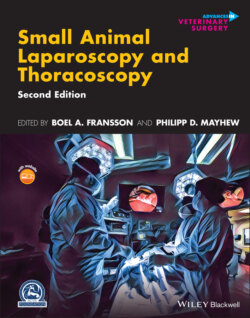Читать книгу Small Animal Laparoscopy and Thoracoscopy - Группа авторов - Страница 76
Light Sources
ОглавлениеAlthough Xenon light sources have been considered high‐end medical technology for almost a decade, LED technology is taking over as the standard. For LED light sources the brightness, clarity, and high color temperature provide true color accuracy. The condition and quality of light‐transmitting cables, cleanliness of lens surfaces, light sensitivity of the camera, and monitor type also contribute to image brightness and quality, as explained earlier in the imaging‐chain section of this chapter [1–5, 8,13–16].
Xenon technology is still sometimes required for special purposes such as fluorescence imaging as detailed further in the text below. When Xenon units are necessary, the range in power varies from 100 to 300 W. The wattage of a light source is not necessarily indicative of its brightness but reflects the energy required to power it. This does not directly correlate to its output, which is measured in lumens. As a result, wattage alone is not valid for comparison of light sources of different types. For example, an LED 150 W light source emits the amount of light similar to a 175 W xenon light source [1–5].
Figure 3.6 New‐generation electronic LED cold light source CO2mbi LED.
Source: © KARL STORZ SE & Co. KG, Germany.
Xenon light sources still offer excellent tissue color reproduction with light closely approximating that of pure sunlight (5800 °K). However, LED technology is increasingly widespread because of its greater efficiency, longer lifetime, smaller size, and lighter weight. An LED bulb will last approximately 30 000 hours, or 30 times that of a xenon light bulb. One should consider having spare Xenon bulbs in stock, since light sources equipped with two bulbs are now less common for economic reasons [1–5, 13, 15].
When selecting a light source for multidisciplinary endoscopy services, including flexible endoscopy, one must consider the compatibility of the light source with the flexible endoscope connector. Flexible endoscopes for G.I. use typically have a connector with two male parts: the light post and a smaller diameter pipe that connects to an internal pump for insufflation and irrigation. Although the initial cost of a versatile, high‐power LED light source may be high, it could represent considerable savings later, minimizing the need for multiple dedicated units for different purposes.
Currently, LED light sources are available on the market that accommodate general use in small animal laparoscopic and thoracoscopic surgery – all while maintaining full compatibility with other applications such as GI endoscopy, transcervical insemination, or low‐pressure gas vaginoscopy (Figure 3.6).
It is important to consider the potential of some light sources to be converted to multidisciplinary use by applying specific adapters, so they fit the connections required for videogastroscopes. Insufflation can be provided by an external pump which may also support aspiration and irrigation.
When not in use, the light source should always be in standby mode or completely turned off (by pressing a preset camera head button), to avoid any thermal injuries to the patient or risk burning the surgical drapes [1–5, 7, 8].
Recently, a new generation of LED light sources capable of white light, infrared autofluorescence, and NIR/ICG fluorescence applications were launched with several advantages compared to the previous technologies available: Power LED RUBINA® – KARL STORZ SE & Co (Figure 3.7). Although only made for specific use with rigid endoscopy systems, these new units feature the following:
Figure 3.7 A unique state‐of‐the‐art light source combining LED white light and NIR/ICG modes for clinical applications – POWER LED RUBINA.
Source: © KARL STORZ SE & Co. KG, Germany.
Silent work: since there are LED bulbs in the light source, there is no need for active fan cooling or other systems in order to lower the temperature, thus resulting in no noise from working units.
Enhanced background lighting: Power LED RUBINA provides more background illumination than normal Xenon D‐Light P sources, resulting in improved surgical visualization and accuracy.
Improved Safety. Since the Power LED Rubina contains only LED technology and no laser light or Xenon bulbs, these units do not require the use of specific wavelength polarized protecting goggles during procedures, thus resulting in increased safety, freedom, and better ergonomics for the surgeons.
These modern units allow for image overlay of NIR/ICG imaging over the standard white light image, enhancing the surgeons tissue perception.
